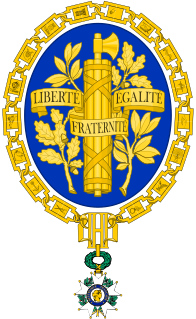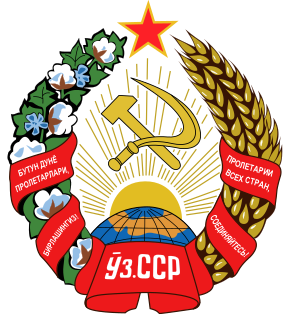
The national emblem of Belarus, which replaced the historic Pahonia arms in a 1995 referendum, features a ribbon in the colours of the national flag, a map of Belarus, wheat ears and a red star. It is sometimes referred to as the coat of arms of Belarus. The emblem is an allusion to one that was used by the Byelorussian SSR, designed by Ivan Dubasov in 1950, with the biggest change being a replacement of the hammer and sickle with an outline map of Belarus. Emblems reminiscent of the times of the Soviet Union are also used in Macedonia, Tajikistan, Uzbekistan and the unrecognised state of Transnistria.

This article outlines current and historical national emblems of France, including heraldic coats of arms, first employed in the Middle Ages, as well as more recent, unofficial non- or quasi-heraldic emblems.

The state of New Hampshire has held two seals since it declared its independence from Great Britain on January 5, 1776. While both seals have been retained, most people are only familiar with the Great Seal due to its corporate use.

"Satyameva Jayate" is a mantra from the ancient Indian scripture Mundaka Upanishad. Following the independence of India, it was adopted as the national motto of India in 26 January 1950. It is inscribed in script at the base of the national emblem. The emblem and the words "Satyameva Jayate" are inscribed on one side of all Indian currency. The emblem is an adaptation of the Lion Capital of Ashoka which was erected around 250 BCE at Sarnath, near Varanasi in the Indian state of Uttar Pradesh. It is inscribed on all currency notes and national documents.
National symbols of the United States are the symbols used to represent the United States of America.

The emblems of the International Red Cross and Red Crescent Movement, under the Geneva Conventions, are to be placed on humanitarian and medical vehicles and buildings, and to be worn by medical personnel and others carrying out humanitarian work, to protect them from military attack on the battlefield. There are four such emblems, three of which are in use: the Red Cross, the Red Crescent, and the Red Crystal. The Red Lion and Sun is also a recognized emblem, but is no longer in use.
Title I: The State and Its Government, is the collection of New Hampshire Revised Statutes Annotated which relate to the state's government as a whole. Like other portions of the RSAs, the Title is divided into Chapters and Sections organized in numbers and subsections organized in lowercase letters.

The coat of arms of the Kirghiz Soviet Socialist Republic was adopted on March 23, 1937 by the government of the Kirghiz Soviet Socialist Republic. The coat of arms is based on the coat of arms of the Soviet Union. It shows symbols of agriculture on a backdrop of the Tian Shan mountains, surrounded by a frame of folk art of the Kyrgyz people. The red star was added in 1948. The rising sun stands for the future of the Kyrgyz nation, the star as well as the hammer and sickle for the victory of communism and the "worldwide socialist community of states".

The emblem of the Uzbek Soviet Socialist Republic was adopted on February 14, 1937 by the government of the Uzbek Soviet Socialist Republic. The emblem is based on the emblem of the Soviet Union. It shows symbols of agriculture and heavy industry (hammer). The rising sun over a map of the Soviet Central Asia symbolizes the future of this region, while the five pointed red star stands for the "socialist revolution on all five continents".
New Hampshire is often noted for its moderate politics and its status as a prominent swing state. Voters predominantly selected Republicans for national office during the 19th and 20th centuries until 1992. Since then, the state has been considered as a swing state, and the Cook Political Report now classifies New Hampshire as "Even" after the 2016 election, reflecting that neither party has an advantage. Since 2006, control of the state legislature and New Hampshire's congressional seats have switched back and forth between Republicans and Democrats in a series of wave elections.
Wooley v. Maynard, 430 U.S. 705 (1977), was a case in which the Supreme Court of the United States held that New Hampshire could not constitutionally require citizens to display the state motto upon their license plates when the state motto was offensive to their moral convictions.
The flag and the coat of arms of Terengganu are state symbols of Terengganu, a state in Malaysia. Like the majority of state symbols for states with Malay royalties, the flag and the arms of Terengganu centre on its royalty, as well as Islam, the state's traditional religion.

The State Emblem of the Soviet Union was adopted in 1923 and was used until the dissolution of the Soviet Union in 1991. Although it technically is an emblem rather than a coat of arms, since it does not follow traditional heraldic rules, in Russian it is called герб, the word used for a traditional coat of arms.

The coat of arms of the Russian Soviet Federative Socialist Republic (RSFSR) was adopted on 10 July 1918 by the government of the Russian Soviet Federative Socialist Republic, and modified several times afterwards. It shows wheat as the symbol of agriculture, a rising sun for the future of the Russian nation, the red star as well as the hammer and sickle for the victory of Communism and the "world-wide socialist community of states".











